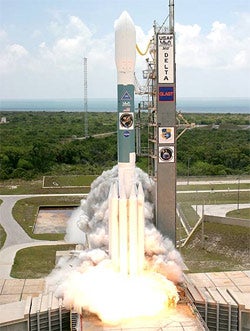NASA’s Gamma-ray Large Area Space Telescope, or GLAST, successfully launched aboard a Delta II rocket from Cape Canaveral Air Force Station in Florida today.
The GLAST observatory separated from the second stage of the Delta II and the flight computer immediately began powering up the components necessary to control the satellite. Twelve minutes after separating from the launch vehicle, both GLAST solar arrays were deployed. The arrays immediately began producing the power necessary to maintain the satellite and instruments. The operations team continues to check out the spacecraft subsystems.
“The entire GLAST Team is elated the observatory is now on-orbit and all systems continue to operate as planned,” said GLAST program manager Kevin Grady of NASA’s Goddard Space Flight Center in Greenbelt, Maryland.
After a 75-minute flight, the GLAST spacecraft was deployed into low Earth orbit. It will begin to transmit initial instrument data after about three weeks. The telescope will explore the most extreme environments in the universe, searching for signs of new laws of physics and investigating what composes mysterious dark matter. It will seek explanations for how black holes accelerate immense jets of material to nearly light speed, and look for clues to crack the mysteries behind powerful explosions known as gamma-ray bursts.
“After a 60-day checkout and initial calibration period, we’ll begin science operations,” said Steve Ritz, GLAST project scientist at Goddard.
“GLAST soon will be telling scientists about many new objects to study, and this information will be available on the internet for the world to see.”










